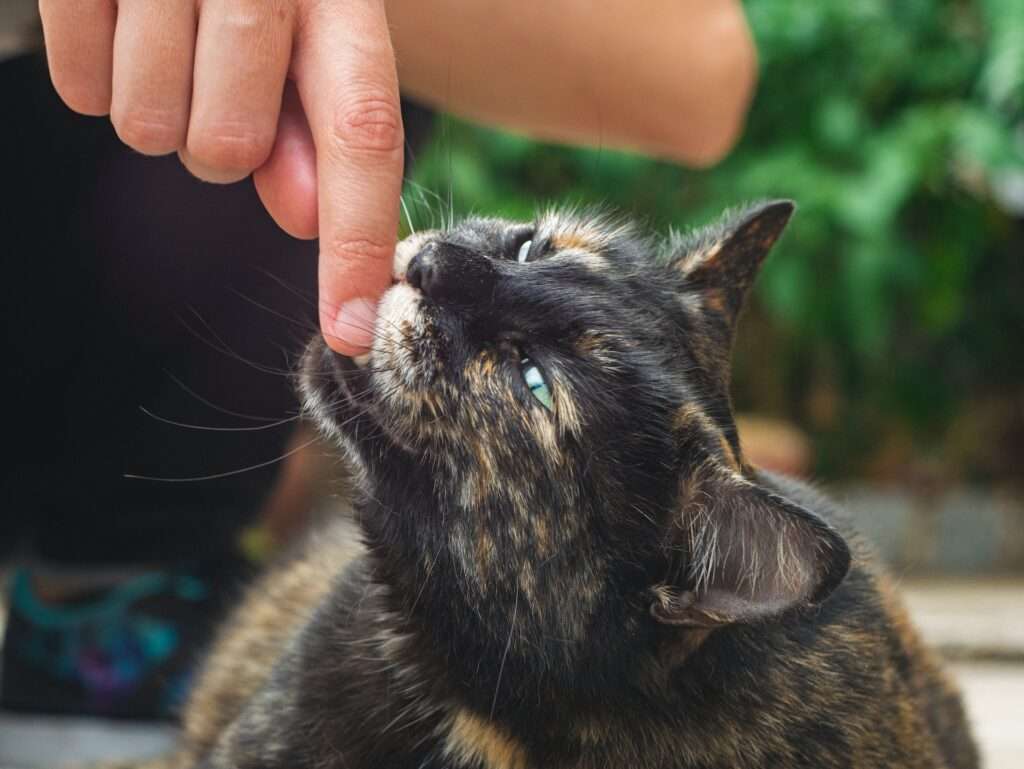Why Does My Cat Bite Me Gently While Purring? Cracking the Code
Cats are fascinating creatures with a unique set of behaviors and characteristics that make them beloved pets. One of the most common behaviors that many cat owners experience is gentle biting while their cats are purring. Although gentle biting while purring can be perplexing, it’s crucial to comprehend why cats display this behavior and its significance.
In this article, we will explore the reasons why cats bite gently while purring, and provide you with insights and tips on how to understand and respond to this behavior. From playful behavior to territorial instincts, we will dive into the various reasons why cats may bite and what you can do to prevent unwanted biting and ensure a happy and healthy relationship with your feline friend.
So, if you’re curious about why your cat is biting you while purring, read on to learn more!
Communication

Cats, those enigmatic and captivating creatures, have a repertoire of communication methods that they employ to interact with their human companions and fellow animals. From subtle body language to melodious vocalizations, feline communication is a fascinating blend of art and instinct. Understanding the various forms of cat communication is essential for building a strong and harmonious bond with our furry friends.
One peculiar aspect of feline communication is biting. While biting can often be associated with aggression or hostility, it is not always the case when it comes to cats. A cat’s bite can carry different implications, and discerning their meanings can help us decipher our feline companion’s intentions.
When a cat bites, it is usually a signal of discomfort or distress. Cats may resort to biting when they feel threatened or scared. In such situations, their body language might accompany the bite with hissing or growling, further emphasizing their unease. These defensive bites serve as a clear message that the cat is not comfortable with the current situation or interaction.
However, not all cat bites are driven by aggression. Sometimes, cats display a peculiar behavior of gently biting their owners while purring. This behavior can indeed bewilder cat owners, as it seems to contradict the general notion of biting as an aggressive act. In these instances, the bite serves a different purpose.
When a contented cat gently nibbles on their owner’s skin while purring, it is often an expression of affection. These gentle bites are commonly referred to as “love bites” or “play bites.” It’s their way of showing fondness and establishing a playful interaction with their beloved humans. Just as kittens playfully nibble on their siblings during their early socialization, adult cats may continue this behavior as a form of bonding and playfulness.
If you find yourself on the receiving end of a cat bite, it’s essential to handle the situation calmly and gently. Reacting with aggression or punishment can worsen the cat’s anxiety or fear, leading to further negative associations. Instead, it is advisable to assess the situation, remove any potential sources of distress, and create a safe and reassuring environment for your cat.
Playful Behavior
During play, it is not uncommon for cats to engage in gentle biting. This form of interaction can be observed when a cat is in pursuit of a toy or actively participating in playtime with their owner. The act of gentle biting is a manifestation of their instinctual hunting skills, as cats possess sharp teeth that are naturally designed to grasp and catch prey.
However, it is crucial to recognize that even during play, cats may become overexcited or stimulated, unintentionally exerting more force than intended. This can potentially lead to accidental injuries for both the cat and their playmate. As responsible pet owners, it is our duty to closely monitor play sessions and intervene promptly if necessary, ensuring the safety and well-being of everyone involved.
To facilitate safe and enjoyable play sessions with your feline companion, there are a few essential guidelines to keep in mind. Firstly, choose appropriate toys that encourage interactive play without posing any hazards. Avoid using your hands or fingers as play objects, as this can inadvertently teach your cat that biting human skin is acceptable behavior.
Opt for toys that allow your cat to engage their natural hunting instincts, such as feather wands, puzzle toys, or interactive treat dispensers. Additionally, it is important to set boundaries during playtime. Establishing consistent rules will help your cat understand acceptable behaviors and avoid any potential rough play.
If your cat becomes too rough during a play session or starts to exhibit signs of aggression, such as hissing or intense biting, calmly disengage from the activity and redirect their attention to a more appropriate toy or activity. This teaches them that rough play is not acceptable and helps maintain a positive and safe play environment. Regular play sessions also offer an opportunity for bonding with your feline companion.
By actively engaging in play and providing them with attention and affection, you strengthen the bond between you and your cat. Take the time to observe their body language and respond accordingly. If your cat shows signs of fatigue or disinterest, allow them to take breaks or offer alternative forms of stimulation, such as interactive puzzle toys or calm petting sessions.
Affectionate Behavior
One common display of affection from cats is through physical contact. You may have experienced the delightful sensation of your feline friend rubbing against your legs, leaving behind a trail of soft fur. This behavior, known as “bunting,” is a cat’s way of marking you with their scent. By rubbing their scent glands against you, they are claiming you as part of their territory and displaying a strong bond.
Another affectionate behavior that cats often engage in is sitting in their owner’s lap. The act of a cat choosing to curl up on your lap signifies a deep level of trust and comfort. It is their way of seeking warmth, security, and a close connection with you. The rhythmic purring that accompanies this intimate moment is an additional expression of their contentment and love.
Gentle biting is yet another intriguing aspect of a cat’s affectionate behavior. Cats may use their mouths to groom or playfully nibble their owners, often referred to as “love bites” or “mouthing.” These bites are typically soft and do not cause any harm. It is their way of reciprocating the social grooming behavior seen among cats, where they groom each other as a display of trust and bonding. By gently biting, cats are essentially grooming and showing their affection to their human companions.
However, it is important to acknowledge that not all biting is motivated by affection. Cats may resort to biting when they are feeling anxious, threatened, or uncomfortable. It is crucial to recognize the context and accompanying cues to decipher the true meaning behind a cat’s bite.
Consistent or aggressive biting should not be dismissed as merely affectionate behavior, as it may indicate an underlying issue that requires attention. If you find yourself uncertain about your cat’s biting behavior, seeking guidance from a veterinarian or professional animal behaviorist can provide valuable insights and help address any potential concerns.
To foster and nurture the affectionate behavior of your cat, it is essential to create an environment that supports their emotional well-being. Spend quality time engaging in activities that your cat enjoys, such as interactive play sessions, gentle petting, or providing them with stimulating toys.
Respect their boundaries and allow them to approach you for affection on their terms. By understanding and responding to their individual preferences, you can cultivate a loving and trusting relationship with your feline companion.
Territorial Behavior

One common way cats mark their territory is through scent. You may have observed your feline friend rubbing against furniture, walls, or even against your legs. This behavior allows cats to deposit their scent and claim ownership of their surroundings. By leaving their scent behind, they create a familiar and reassuring environment while also communicating to other cats that the territory is occupied.
Gentle biting can also be a part of a cat’s territorial behavior. When a cat feels threatened or anxious, they may resort to biting as a means of asserting dominance or defending their territory. This behavior is particularly prevalent during territorial disputes or when a new cat is introduced into the household. Biting in these situations is a cat’s way of sending a clear message to other cats or perceived intruders that their space is to be respected.
In a multi-cat household, it is important to provide each cat with their own space and resources to minimize territorial conflicts. Each cat should have access to separate feeding areas, litter boxes, and resting spots to prevent competition and establish a sense of ownership. Adequate vertical space, such as cat trees or shelves, can also help cats claim their territory and maintain a sense of security.
Additionally, implementing a gradual and supervised introduction process when introducing a new cat can help alleviate potential territorial issues. By allowing the cats to become familiar with each other’s scents through scent swapping and gradual visual introductions, you can facilitate a smoother transition and minimize stress and aggression.
Creating an enriching environment for your cats is another effective way to address territorial behavior. Providing an array of toys, scratching posts, and interactive activities can help redirect their focus and energy towards positive outlets. Regular play sessions can help relieve stress and establish a bond between you and your cats, promoting a sense of security within their territory.
If you notice signs of escalated territorial behavior, such as increased aggression, urine marking, or persistent conflicts between cats, it is crucial to seek guidance from a veterinarian or a professional animal behaviorist. They can provide expert advice tailored to your specific situation and offer strategies to address and manage territorial issues.
Training and Socialization
Training a cat involves teaching them desired behaviors and ensuring they understand and follow household rules. One common training objective is litter box usage. By introducing cats to a clean and easily accessible litter box, and positively reinforcing their use of it, we can establish good litter box habits. Additionally, training cats to use a scratching post instead of furniture helps preserve your belongings while providing an outlet for their natural scratching instincts.
Training is not limited to practical skills alone. Cats can also be trained to respond to cues, such as coming when called or performing tricks. Positive reinforcement techniques, such as using treats or praise, are effective in encouraging desired behaviors. Consistency, patience, and short training sessions are key to successfully training a cat, as they have their own unique personalities and may require different approaches.
Socialization is equally important for cats. Early and ongoing exposure to various people, animals, and environments helps cats develop confidence and adaptability. Proper socialization can prevent fear and aggression issues, making cats more comfortable and at ease in different situations.
Regular playtime, gentle handling, and exposure to new experiences in a controlled and positive manner can help cats become well-adjusted and sociable companions. It’s worth noting that training and socialization should always be approached with respect for the individual cat’s temperament and comfort level.
Some cats may be more reserved or less interested in training, and it is essential to recognize and accommodate their unique needs and preferences. Trust-building exercises, allowing cats to approach and interact with new stimuli at their own pace, can help create a safe and positive learning environment.
Seeking Professional Help
If you find yourself dealing with persistent biting behavior or other negative behaviors from your cat, it may be beneficial to seek professional help. While cats can exhibit a range of behaviors, consistent and problematic biting can be a cause for concern. Consulting a veterinarian or an animal behaviorist can provide you with expert guidance and personalized recommendations to address the issue effectively.
Professional help is particularly crucial when dealing with biting behaviors that may be rooted in underlying health issues or psychological factors. A veterinarian can conduct a thorough examination to rule out any medical conditions that could be contributing to your cat’s behavior. They can also provide valuable insights into your cat’s overall well-being and recommend appropriate treatments or interventions if necessary.
An animal behaviorist, on the other hand, specializes in understanding and modifying animal behavior. They can assess your cat’s specific biting behavior, evaluate its triggers and context, and develop a tailored behavior modification plan. This may include techniques such as positive reinforcement training, environmental enrichment, or desensitization exercises.
Working closely with a professional can help you address the root causes of the biting behavior and develop a comprehensive strategy to promote positive change. In the process of seeking professional help, it is important to maintain a patient and understanding approach. Behavior changes take time and consistency.
Your cat’s biting behavior may not be resolved overnight, but with the right guidance and a commitment to their well-being, you can make progress. Be prepared to follow through with the recommendations provided by the professional, as consistent implementation of the recommended strategies is essential for achieving positive results.
Conclusion
In conclusion, gentle biting in cats can be a complex behavior that carries various meanings depending on the context. While it can indicate affection, playfulness, or territoriality, it’s important to consider the bigger picture and be attentive to your cat’s overall well-being.
By deepening your understanding of your cat’s behavior and body language, you can decipher the messages they’re trying to convey. Providing proper training and socialization from the early stages of your cat’s life can help establish positive behaviors and prevent potential issues.
However, if you find yourself facing consistent or problematic biting behaviors, it’s crucial to seek professional help. Veterinary experts and animal behaviorists have the knowledge and experience to assess your cat’s behavior, identify any underlying causes, and provide personalized guidance and solutions.
Remember, building a strong and healthy relationship with your cat takes time, patience, and a commitment to their emotional and physical well-being. By nurturing a bond based on trust, understanding, and positive reinforcement, you can create a harmonious and loving environment where both you and your feline friend can thrive.
Frequently Asked Questions
Why does my cat bite me gently while purring?
Gentle biting while purring can have different meanings depending on the context. It can be a sign of affection, playfulness, or even territorial behavior. Cats have unique ways of communicating, and understanding their body language and overall behavior can help decipher their intentions.
Why does my kitten bite me while purring?
Kittens may bite while purring as a playful behavior, a sign of affection, or part of their teething process. Monitor their behavior, offer appropriate toys, and consult with a professional if needed.
Is gentle biting from my cat a cause for concern?
In most cases, gentle biting from a cat is not a cause for concern. It is often a natural behavior and may be their way of expressing love, playfulness, or asserting their territory. However, if the biting becomes aggressive, frequent, or is accompanied by other negative behaviors, it may be necessary to seek professional help to address any underlying issues.
How can I differentiate between affectionate biting and aggressive biting?
Differentiating between affectionate biting and aggressive biting can be challenging. Pay attention to your cat’s overall body language and the context of the behavior. Affectionate biting is usually accompanied by purring, relaxed body posture, and a gentle approach. Aggressive biting, on the other hand, may involve hissing, growling, flattened ears, and a tense body posture. If you’re unsure, it’s best to consult with a veterinarian or animal behaviorist for an accurate assessment.
How can I discourage my cat from biting me too hard?
If your cat tends to bite too hard during play, it’s essential to teach them appropriate boundaries. Use positive reinforcement techniques by rewarding gentle play and withdrawing attention or ending the play session when the biting becomes too rough. Redirect their attention to appropriate toys or objects they can bite and scratch. Consistency, patience, and regular playtime can help teach your cat to control the intensity of their bites.
When should I seek professional help for my cat’s biting behavior?
If your cat’s biting behavior becomes aggressive, frequent, or is accompanied by other negative behaviors, it may be necessary to seek professional help. Consult with a veterinarian or animal behaviorist who can assess your cat’s behavior, identify any underlying causes, and provide personalized guidance and solutions.






